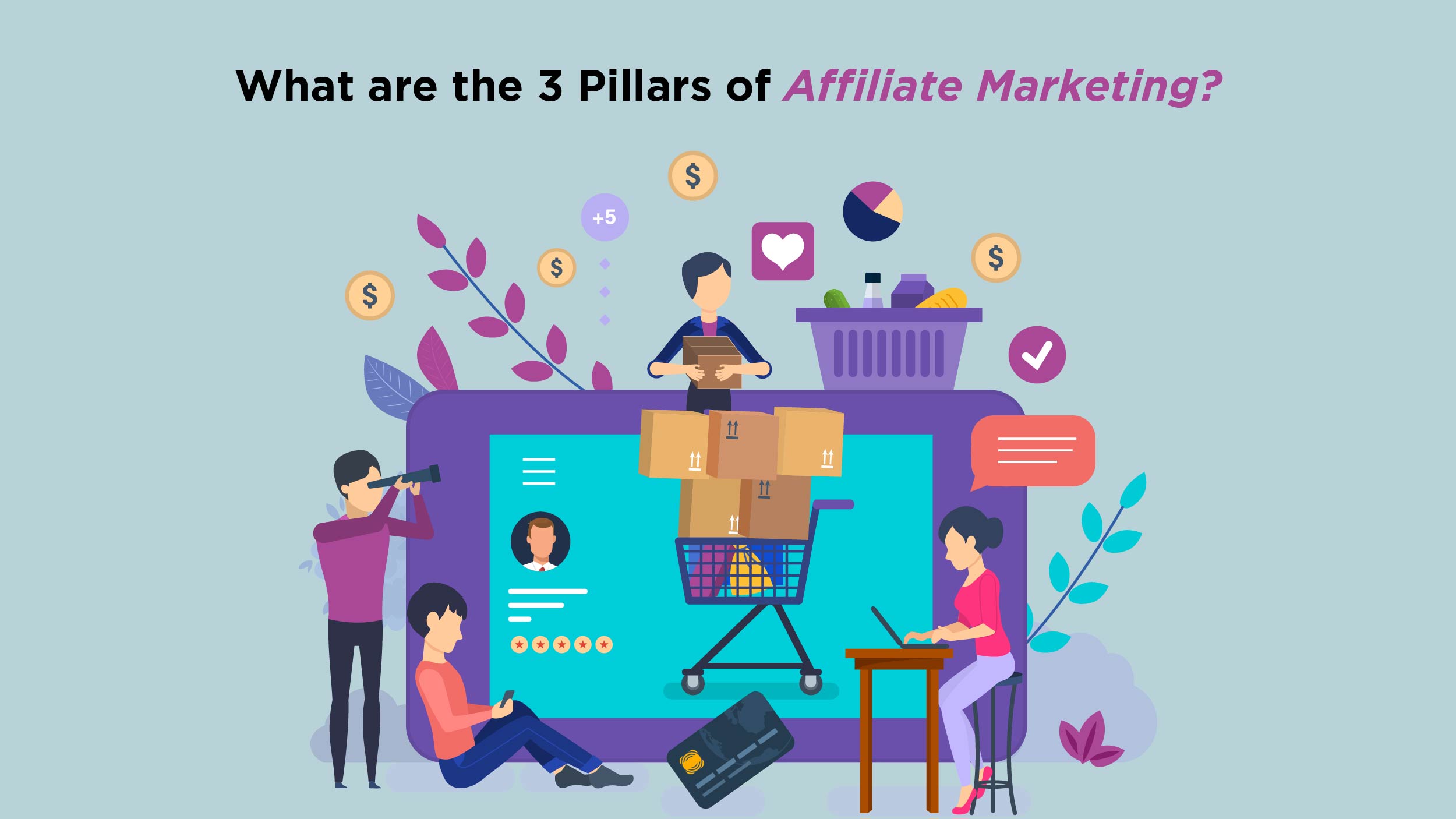Affiliate marketing is a great way to make some additional income. You can join as an affiliate marketer for other companies, or you can start one for your brand.
This way both creators and brands can benefit. Creators can generate extra cash flow by promoting the brand’s link, and companies benefit from this outreach as well. According to studies, this is the 2nd most popular income for creators (56%).
This detailed guide will show you how to start promoting other companies as an affiliate marketer. We’ll cover how to get started with affiliate marketing, best practices to help you make more money, and online marketing tips for creating an effective affiliate network.
What is Affiliate Marketing?
Affiliate marketing is where publishers earn a commission by promoting products or services from other retailers or advertisers through affiliate links. Consequentially, the affiliate partner receives a payout for producing specific outcomes for the retailer or advertiser.
Affiliates usually earn rewards for completed sales. Also, some affiliate platforms can pay you for generating leads, captivating free trial participants, getting website clicks, or promoting app downloads.
Usually, affiliate programs are free of charge. If done correctly, a successful affiliate strategy has the potential to evolve from a part-time cash flow into a profitable online business that generates massive income.
How Does Affiliate Marketing Work?
Affiliate marketing utilizes the skills of a range of people for a more successful marketing plan while giving contributors a piece of the profit since it works by dividing the responsibility of product promotion and creation between parties. It has 3 components:
- product makers and the seller
- a partner or advertiser
- consumer
A potential customer is directed to the merchant’s website when they click on an affiliate’s special link. The affiliate receives a commission from the retailer if they complete a desired activity (such as filling out a form) or make a purchase.
Types of Affiliate Marketing Programs
There are three types of affiliate marketing programs: unattached, related, and attached.
Unattached
The first type is ideal when you need more authority in the product’s niche, establishing no direct link with the customer. This strategy typically includes running pay-per-click (PPC) ad campaigns using the affiliate link, aiming for clicks, purchases, and commission payouts.
It is appealing due to the lack of necessary legwork. Affiliate relies on building trust and a good reputation with an online audience. Certain marketers may lack the time or inclination to nurture such connections, making this marketing approach their top choice.
Amazon’s affiliate program is a great example. Pick a product, get the referral link, and start promoting.
Related
Affiliate marketing involves promoting niche-related products and services, even if they are not personally used. Marketers, with an audience on platforms like blogs or YouTube, establish trust as credible sources for product recommendations despite non-personal use.
Related affiliate marketing could increase income but poses the risk of endorsing untested products or services, potentially leading to a loss of audience trust.
NerdWallet is a well-recognized affiliate marketing platform in the finance niche. They offer advice and evaluations on various financial products, such as credit cards and personal loans.
NerdWallet earns affiliate commissions by referring users to financial institutions through its website.
Involved
Involved affiliate refers to the recommendation of products or services that affiliate marketers have used and believe in.
In this, the marketer uses influence to promote services or products that might be genuinely helpful to the followers, instead of paying to get clicks on a banner ad. Although earning this type of audience trust takes time, doing so is essential to creating a long-lasting business.
What are the 3 Pillars of Affiliate Marketing?
 The 3 pillars of affiliate marketing include:
The 3 pillars of affiliate marketing include:
- Build good relationships: Having a good bond with partners is key. Stay in touch with them and support them when needed. Know what they want and need. This creates trust and helps everyone succeed.
- Create great content: make blogs, videos, posts, etc. that are useful and engaging for your audience. Be real and honest in your content. This builds trust with people and turns readers into buyers.
- Drive conversions: The main goal is to get people to buy, sign up, or take action. Know your audience well. Pick good products or services to promote. Use smart ways to get traffic and turn them into customers. Things like targeting the right people, choosing the right niche, getting traffic, tracking results, and improving over time.
How To Get Started In Affiliate Marketing?
 Follow this step-by-step guide to launch your affiliate venture.Choose Your Platform and Approach
Follow this step-by-step guide to launch your affiliate venture.Choose Your Platform and Approach
The initial step involves determining the platform to build your audience around. Every affiliate marketer employs a distinct approach and platform.
You can select from numerous affiliate ideas based on different methods:
- Niche-focused review sites: These websites review products for a specific audience or compare a product line against competitors. This method necessitates creating content related to the review space and posting regularly to attract an audience.
- Digital content creators: Bloggers, YouTubers, and social media influencers fall into this category. They craft niche content that resonates with a target audience. The goal is to organically introduce niche products that their audience will appreciate, thereby increasing the chances of earning an affiliate commission through purchases.
- Courses, events, and workshops: If you’re an educator, you can integrate affiliate partnership offers into your events.
Regardless of your chosen path, authenticity and audience building are the two paramount elements for affiliate success. If you cannot authentically connect with your audience, it’s unlikely you’ll succeed in converting them into affiliate sales.
Also Read: How to Create an Effective Brand Strategy: A Step-by-Step Guide
To choose a platform and method, consider: Which platforms are your go-to? Which ones do you comprehend best?
Some common platforms that affiliate marketers use include:
- Blogging
- TikTok
- Facebook
- Pay-per-click (PPC)
- YouTube
Beginning with a familiar marketing platform aids in crafting high-quality content. This can foster a robust, engaged audience that converts into sales.
Pinpoint Your Niche And Target Audience
When selecting a niche, aim for something you’re passionate and knowledgeable about. This lends authenticity and positions you as a trusted source for prospective customers. It also guides which products and brands to promote.Know your audience extremely well. Understand why they follow you in the first place. If you clearly know what they like, you can recommend relevant products.
You can then earn more affiliate income by meeting their needs.
Find Your Products
To earn trust, your audience must be connected to your content. The services or products you promote should be something your followers need.
Recommending the wrong service can harm your credibility and audience engagement.
There are numerous affiliate networks and marketplaces available for you to choose the right products or brands.
Some of them include Affiliate Future, AvantLink, CJ, and ClickBank.
Choose the Right Affiliate Program
Select a program that suits your brand and income aspirations. Guarantee that the product or service promoted fits the promotional platform.
For example, Instagram is great for promoting home decor and clothes. But if you’re selling software, platforms like blogs or YouTube, where you can explain things in detail will be better.
Tips For Success in Affiliate Marketing
- Make people believe you: Be open about your links and honest about your suggestions. Do not hide anything from viewers. Give them the whole truth. Connect with your crowd in a real way to build trust and reliability. Act naturally and be yourself.
- Chat with someone who understands the product: Get in touch with professionals or experienced users to gain genuine insight. Hear from true experts, not just based on guesses.
Use their know-how in your promotions to make your recommendations more credible. Expert input makes your content trustworthy.
- Produce a tutorial for the product: Show how the item tackles a problem or fulfills a need to teach your audience. Give them reasons to believe in the product’s usefulness.
- Build an email list: Offer valuable stuff or rewards to encourage site visitors to subscribe. Give them incentives for their contact information. Send your email subscribers relevant content and special deals to build rapport and keep them loyal.
- Discover relevant search terms: Research keywords linked to your niche to optimize content for search engines. Use the right terms for better visibility. Use keyword tools to identify search terms with high intent that match your affiliate products.
- Consider your viewpoint. Set yourself apart by offering a fresh perspective or angle on the products you promote. Avoid generic pitches; make them unique. Tailor messaging to align with your target audience’s interests, preferences, and problems. Speak their language and relate to their lives.
- Establish your distribution approach Pinpoint the most effective channels to reach your target audience based on their preferences and behaviors. Cater to their habits. Prioritize where you put effort to get the best results across places and ways you mark.
- Bonus Offers: Make people want to buy through special deals or lower prices to boost the affiliate offer’s appeal. Promote limited-time bonuses or offers to create a sense of urgency, pushing people to act.
- Follow the rules: Learn about laws and guidelines for affiliate marketing to stay within bounds. Be upfront about your affiliate links and obey all legal requirements to build trust with your audience.
Which Metrics are Used to Measure the Success of Affiliate Marketing Campaigns?
Several crucial metrics are commonly used:
Click rate: Link interactions are tallied as clicks, signaling audience engagement and interest; this core measure reflects promotional effectiveness in driving site traffic. It’s a fundamental gauge of campaign success.
Conversion: The conversion rate, or percentage of visitors taking desired actions like purchases or form submissions after clicking an affiliate link, indicates a campaign’s ability to spur conversions; a higher rate equates to better success.
Sales: Direct revenue or sales generated via affiliate referrals clearly showcase a program’s monetary impact on an advertiser’s earnings. Tracking this metric offers transparent insight into financial gains resulting from promotional efforts.
ROI: Return on Investment evaluates profitability by comparing revenue against costs incurred, providing a comprehensive assessment of a campaign’s overall efficacy and monetary viability.
AOV: Customers’ average expenditure when making affiliate-referred purchases is captured in the Average Order Value (AOV) metric. Monitoring this sheds light on traffic quality and cross-selling and upselling strategy success.
Impressions: These are when people see your links, ads, or widgets. They show how many people saw your marketing campaign. Tracking impressions tells you how visible it is.
Click-through rate: CTR is the percentage of visitors that clicked. A high CTR means more people want to learn about what you offer. It shows if your campaign caught people’s interest.
Can Anyone Do Affiliate Marketing?
Success in affiliate marketing requires patience, expertise, and experience. Given that you do not have to make an initial investment in real products or inventory, it might, however, be more suited to beginners than other platforms. Affiliate marketing for Instagram has become a popular and effective way for influencers and businesses to earn money by promoting products or services to their followers.
It’s a win-win situation for the affiliate and the business they are promoting when affiliates use special referral links since they can get paid a commission on any purchases made via their link. For Instagram users of all sizes, affiliate marketing may be a successful source of money with the appropriate strategy and approach.
Can People Do Affiliate Marketing With Zero Money?
Yes, there are several low-cost or free affiliate networks with zero investment. However, to be successful you will need to develop a massive online audience through activities like blogging, social media posting, etc. This is why affiliate marketing for bloggers is becoming famous due to zero investments and high-profit value.
Which Affiliate Marketing Pays the Most?
Affiliate programs frequently offer attractive payouts. These examples demonstrate high-paying opportunities:
Refersion facilitates diverse affiliate programs across industries, offering lucrative earnings potential.
Canva‘s popular graphic design tool provides competitive commissions for promoting its services to new users.
Fiverr, the freelance marketplace, has an affiliate program that generates highly rewarding customer referrals.
SEMrush, a comprehensive digital marketing platform, presents affiliates with substantial commissions per sale or trial activation.
As an email marketing service provider, GetResponse offers recurring commissions through its competitive affiliate structure.
ConvertKit, an email marketing platform, enables affiliates to earn ongoing income via a recurring commission model.
End Note
If you’re wondering if affiliate marketing is good or bad, Well, as long as you do it right by abiding by laws and regulations, it is good. With its proven track record, the affiliate continues to provide opportunities for growth and success in the ever-evolving digital landscape.


Comments are closed.